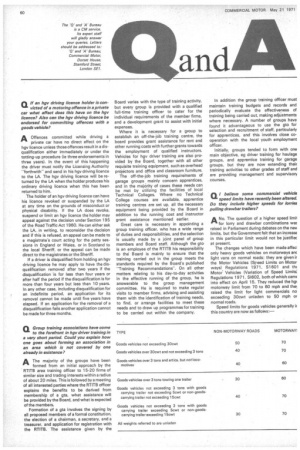Group training associations have come to the forefront in hgv
Page 62

If you've noticed an error in this article please click here to report it so we can fix it.
driver training in a very short period. Could you explain how one goes about forming an association in an area which is not covered by one already in existence?
AThe majority of the groups have been
formed from an initial approach by the RTITB area training officer to 15-20 firms of similar size and trading interests within a radius of about 20 miles. This is followed by a meeting of all interested parties where the RTITB officer explains the benefits to be derived from membership of a gta, what assistance will be provided by the Board, and what is expected of the members, Formation of a gta involves the signing by all proposed members of a formal constitution, the election of a chairman, a secretary, and a treasurer, and application for registration with the RTITB. The assistance given by the Board varies with the type of training activity, but every group is provided with a qualified full-time training officer to cater for the individual requirements of the member firms, and a development grant to assist with initial expenses.
Where it is necessary for a group to establish an off-the-job training centre. the board provides grant assistance for rent and other running costs with further grants towards the employment of qualified instructors. Vehicles for hgv driver training are also provided by the Board, together with all other requisite training equipment, such as overhead projectors and office and classroom furniture.
The off-the-job training requirements of garage groups . mainly concern apprentices, and in the majority of cases these needs can be met by utilizing the facilities of local Technical Colleges. Where no Technical College courses are available, apprentice training centres are set up, all the necessary equipment being provided by the Board in addition to the running cost and instructor grant assistance mentioned earlier.
Great care is necessary in appointing a group training officer, who has a wide range of duties and responsibilities, and the selection is usually made by a joint panel of group members and Board staff. Although the gto is an employee of the RTITB his responsibility to the Board is mainly to ensure that the training carried out in the group meets the standards required by the Board's published -Training Recommendations". On all other matters relating to his day-to-day activities in the effective running of the group, he is answerable to the group management committee. He is required to make regular visits to member firms, advising and assisting them with the identification of training needs, to find, or arrange facilities to meet these needs and to draw up programmes for training to be carried out within the company.
In addition the group training officer must maintain training budgets and records and periodically evaluate the effectiveness of training being carried out, making adjustments where necessary. A number of groups have found it advantageous to use the gto for selection and recruitment of staff, particularly for apprentices, and this involves close cooperation with the local youth employment officer.
Initially, groups tended to form with one main objective, eg driver training for haulage groups, and apprentice training for garage groups, but they are now extending their training activities to other grades of staff and are providing management and supervisory courses.






























































































































